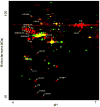Assessing Amide Proton Transfer (APT) MRI Contrast Origins in 9 L Gliosarcoma in the Rat Brain Using Proteomic Analysis
- PMID: 25622812
- PMCID: PMC4496258
- DOI: 10.1007/s11307-015-0828-6
Assessing Amide Proton Transfer (APT) MRI Contrast Origins in 9 L Gliosarcoma in the Rat Brain Using Proteomic Analysis
Abstract
Purpose: To investigate the biochemical origin of the amide photon transfer (APT)-weighted hyperintensity in brain tumors.
Procedures: Seven 9 L gliosarcoma-bearing rats were imaged at 4.7 T. Tumor and normal brain tissue samples of equal volumes were prepared with a coronal rat brain matrix and a tissue biopsy punch. The total tissue protein and the cytosolic subproteome were extracted from both samples. Protein samples were analyzed using two-dimensional gel electrophoresis, and the proteins with significant abundance changes were identified by mass spectrometry.
Results: There was a significant increase in the cytosolic protein concentration in the tumor, compared to normal brain regions, but the total protein concentrations were comparable. The protein profiles of the tumor and normal brain tissue differed significantly. Six cytosolic proteins, four endoplasmic reticulum proteins, and five secreted proteins were considerably upregulated in the tumor.
Conclusions: Our experiments confirmed an increase in the cytosolic protein concentration in tumors and identified several key proteins that may cause APT-weighted hyperintensity.
Conflict of interest statement
Figures




Similar articles
-
Amide proton transfer (APT) contrast for imaging of brain tumors.Magn Reson Med. 2003 Dec;50(6):1120-6. doi: 10.1002/mrm.10651. Magn Reson Med. 2003. PMID: 14648559
-
Amide proton transfer imaging of 9L gliosarcoma and human glioblastoma xenografts.NMR Biomed. 2008 Jun;21(5):489-97. doi: 10.1002/nbm.1216. NMR Biomed. 2008. PMID: 17924591 Free PMC article.
-
Quantitative assessment of the effects of water proton concentration and water T1 changes on amide proton transfer (APT) and nuclear overhauser enhancement (NOE) MRI: The origin of the APT imaging signal in brain tumor.Magn Reson Med. 2017 Feb;77(2):855-863. doi: 10.1002/mrm.26131. Epub 2016 Feb 2. Magn Reson Med. 2017. PMID: 26841096 Free PMC article.
-
Quantitative assessment of amide proton transfer (APT) and nuclear overhauser enhancement (NOE) imaging with extrapolated semi-solid magnetization transfer reference (EMR) signals: Application to a rat glioma model at 4.7 Tesla.Magn Reson Med. 2016 Jan;75(1):137-49. doi: 10.1002/mrm.25581. Epub 2015 Mar 5. Magn Reson Med. 2016. PMID: 25753614 Free PMC article.
-
Amide proton transfer imaging of tumors: theory, clinical applications, pitfalls, and future directions.Jpn J Radiol. 2019 Feb;37(2):109-116. doi: 10.1007/s11604-018-0787-3. Epub 2018 Oct 19. Jpn J Radiol. 2019. PMID: 30341472 Review.
Cited by
-
Insight into the quantitative metrics of chemical exchange saturation transfer (CEST) imaging.Magn Reson Med. 2017 May;77(5):1853-1865. doi: 10.1002/mrm.26264. Epub 2016 May 12. Magn Reson Med. 2017. PMID: 27170222 Free PMC article.
-
Brain investigations of rodent disease models by chemical exchange saturation transfer at 21.1 T.NMR Biomed. 2018 Nov;31(11):e3995. doi: 10.1002/nbm.3995. Epub 2018 Jul 27. NMR Biomed. 2018. PMID: 30052292 Free PMC article.
-
Prospective acceleration of parallel RF transmission-based 3D chemical exchange saturation transfer imaging with compressed sensing.Magn Reson Med. 2019 Nov;82(5):1812-1821. doi: 10.1002/mrm.27875. Epub 2019 Jun 17. Magn Reson Med. 2019. PMID: 31209938 Free PMC article.
-
Predicting IDH mutation status in grade II gliomas using amide proton transfer-weighted (APTw) MRI.Magn Reson Med. 2017 Sep;78(3):1100-1109. doi: 10.1002/mrm.26820. Epub 2017 Jul 16. Magn Reson Med. 2017. PMID: 28714279 Free PMC article.
-
Amide Proton Transfer Imaging vs Diffusion Kurtosis Imaging for Predicting Histological Grade of Hepatocellular Carcinoma.J Hepatocell Carcinoma. 2020 Oct 9;7:159-168. doi: 10.2147/JHC.S272535. eCollection 2020. J Hepatocell Carcinoma. 2020. PMID: 33117750 Free PMC article.
References
-
- Stupp R, Mason WP, van den Bent MJ, et al. Radiotherapy plus concomitant and adjuvant temozolomide for glioblastoma. N Engl J Med. 2005;352:987–96. - PubMed
-
- Wen PY, Macdonald DR, Reardon DA, et al. Updated response assessment criteria for high-grade gliomas: response assessment in neuro-oncology working group. J Clin Oncol. 2010;28:1963–72. - PubMed
-
- Zhou J, Payen J, Wilson DA, et al. Using the amide proton signals of intracellular proteins and peptides to detect pH effects in MRI. Nature Med. 2003;9:1085–90. - PubMed
-
- Zhou J, Lal B, Wilson DA, et al. Amide proton transfer (APT) contrast for imaging of brain tumors. Magn Reson Med. 2003;50:1120–6. - PubMed
Publication types
MeSH terms
Substances
Grants and funding
- R01 EB009731/EB/NIBIB NIH HHS/United States
- R01CA166171/CA/NCI NIH HHS/United States
- P30CA006973/CA/NCI NIH HHS/United States
- P30 CA006973/CA/NCI NIH HHS/United States
- R01EB009731/EB/NIBIB NIH HHS/United States
- R01 NS083435/NS/NINDS NIH HHS/United States
- HHSN268201000032C/PHS HHS/United States
- R21 EB015555/EB/NIBIB NIH HHS/United States
- R01 CA166171/CA/NCI NIH HHS/United States
- R21EB015555/EB/NIBIB NIH HHS/United States
- R01NS083435/NS/NINDS NIH HHS/United States
- HHSN268201000032C/HL/NHLBI NIH HHS/United States
LinkOut - more resources
Full Text Sources
Other Literature Sources
Medical

